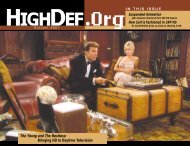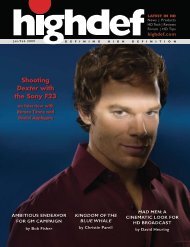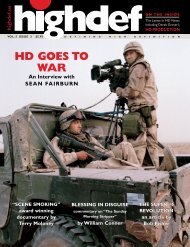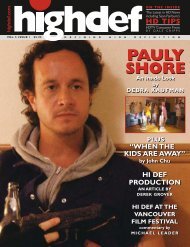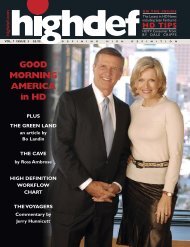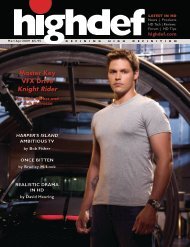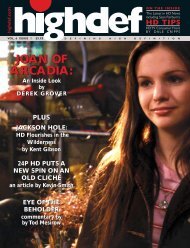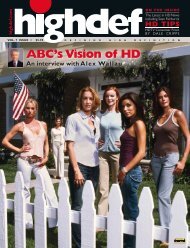Braverman Behind-the-Scenes for Bottle Rocket
Braverman Behind-the-Scenes for Bottle Rocket
Braverman Behind-the-Scenes for Bottle Rocket
- No tags were found...
Create successful ePaper yourself
Turn your PDF publications into a flip-book with our unique Google optimized e-Paper software.
Owen Wilson, RobertMusgrave and LukeWilson on <strong>the</strong> set of <strong>the</strong>cult classic <strong>Bottle</strong> <strong>Rocket</strong>.<strong>Braverman</strong> <strong>Behind</strong>-<strong>the</strong>-<strong>Scenes</strong> <strong>for</strong><strong>Bottle</strong> <strong>Rocket</strong>Photo courtesy of Sony Picturesb y B r i a n C a l iCinematographer Barry <strong>Braverman</strong>, <strong>the</strong> Director of Photography <strong>for</strong> <strong>the</strong> original, 13-minuteblack-and-white <strong>Bottle</strong> <strong>Rocket</strong> short that was <strong>the</strong> basis <strong>for</strong> filmmaker Wes Anderson’s1996 cult classic, recently shot The Making of <strong>Bottle</strong> <strong>Rocket</strong> <strong>for</strong> <strong>the</strong> Blu-ray release(Criterion Collection) of <strong>the</strong> feature with <strong>the</strong> Panasonic VariCam 2700 P2 HD VariCam. Theoriginal behind-<strong>the</strong>-scenes documentary features interviews with Anderson, producer James L.Brooks, actors James Caan and Luke and Owen Wilson, among o<strong>the</strong>rs, and revisits <strong>the</strong> Texaslocations where <strong>the</strong> film was shot.<strong>Bottle</strong> <strong>Rocket</strong> is a lovingly detailed, visually witty and warm portrait of three young misfits,best friends Anthony (Luke Wilson), Dignan (Owen Wilson), and Bob (Robert Musgrave).The trio stage a wildly complex, mildly successful robbery of a small bookstore, <strong>the</strong>n go “on<strong>the</strong> lam,” where <strong>the</strong>y befriend a real thief, Mr. Henry (Caan). Martin Scorsese has called <strong>Bottle</strong><strong>Rocket</strong>, <strong>the</strong> film that put Anderson (Rushmore, The Royal Tenenbaums) and <strong>the</strong> Wilson bro<strong>the</strong>rson <strong>the</strong> map, “a picture without a trace of cynicism, that obviously grew out of its director’saffection <strong>for</strong> his characters in particular and <strong>for</strong> people in general…. a rarity.”<strong>Braverman</strong>, who had previously worked with <strong>the</strong> AJ-HPX2700 VariCam on wildlife shootsand indie projects, calls it <strong>the</strong> “ultimate non-fiction camera.” “I never considered anything buta top-end camera <strong>for</strong> this project,” <strong>Braverman</strong> said. “I was dealing with A-list talent who had notime <strong>for</strong> do-overs. It makes sense to have a camera like HPX2700 when you’re working at this6 7
Photo courtesy of Sony Picturesoptimo rougewideThe gang in yellowjump suits executes <strong>the</strong>imperfect robbery insideHinckley Cold Storage.8level. Essentially, you’re paying <strong>for</strong> peace ofmind and <strong>the</strong> confidence that <strong>the</strong> camera canhandle and survive an unpredicted event.”And The Making of <strong>Bottle</strong> <strong>Rocket</strong> wasnot without sudden changes of plans. “I wasshooting <strong>the</strong> Jim Brooks’ (The Mary TylerMoore Show, Broadcast News, The Simpsons)interview on <strong>the</strong> Fox lot, and had 90 minutesscheduled with him,” <strong>Braverman</strong> recounted.“I had a ground-level office rigged out withfull-bore HMI lighting. The famously reticentBrooks walked in and asked me to turn off <strong>the</strong>lights and start shooting in five minutes.”“I had to wing it with available daylightthrough a window, and a hodge-podge ofmessy office lighting, but <strong>the</strong> HPX2700 couldpull it out,” he continued. “The HPX2700 isclearly a craft-driven and per<strong>for</strong>mance-orientedtool that can excel when things change at<strong>the</strong> last second. It’s not about some potentialresolution numbers. The P2 VariCam offersresolution appropriate <strong>for</strong> professionals earninga living: it’s not about imagers <strong>the</strong> size ofa battleship.”“The HPX2700 produces very flatteringimages when working with talent, courtesy of<strong>the</strong> VariCam cinematic look and <strong>the</strong> camcorder’s10-bit capture,” <strong>Braverman</strong> noted. “Fleshtones appear organic with well-modulatedshadow details. The image processing isextremely sophisticated <strong>for</strong> capturing <strong>the</strong> skintones of celebrities, who are understandablyfocused on every nook and cranny of <strong>the</strong>ircomplexions. This was especially true in thiscase, given <strong>the</strong> Blu-ray release.”“The HPX2700 creates a distinguishedlook that can’t be reproduced in a lowerclassof camera,” he added. “I don’t confuseincreased resolution with superior images.There are times you don’t necessarily want tosee maximum resolution; with portraits andclose-ups, <strong>for</strong> instance, you actually want lessresolution, not more. The VariCam 2700, inshort, is effective as a tool <strong>for</strong> a working filmmakerat a level far beyond <strong>the</strong> number ofpixels in <strong>the</strong> imager. After all, I can’t remember<strong>the</strong> last production I worked on about atest chart!”Designed as a premium-quality, workhorseHD cinematography camcorder, <strong>the</strong>VariCam 2700 combines VariCam’s renownedfilmic look with key functions including variableframe rates, wide dynamic range andadvanced master-quality, 10-bit 4:2:2 AVC-Intra recording.<strong>Braverman</strong> said he makes judicious useof <strong>the</strong> HPX2700’s full range of variable framerates (from 1 fps to 60 fps in 720p mode). “Itend to use off-speed in ways that are subtle,”he noted. “Shooting at 25 or 26fps can lend acertain gravitas to actors’ reactions, especiallyif you’re working with non-professionals on anindie project. And when I’m shooting with along lens on a wildlife doc, you have to shootovercranked. The HPX2700 does off-speedwith <strong>the</strong> most versatility and most robust colorFollowing <strong>the</strong> tremendous success of <strong>the</strong> Optimo Rouge 30-80 lens – <strong>the</strong> firstin <strong>the</strong> Optimo DP series – Thales Angenieux introduces <strong>the</strong> Optimo Rouge16-42 Wide Angle Zoom. It features a wide angle position of 16mm (75.4degrees), a fast aperture of T2.8, calibrated focus marks, no ramping orbreathing all in a lightweight, compact 4.2 lb package. The Optimo Rouge16-42 Wide Angle Zoom delivers industry proven features with <strong>the</strong> per<strong>for</strong>mance,functionality and ergonomics that DP’s demand at a cost effective price. Onlyfrom Thales Angenieux.973.812.3858 • angenieux@tccus.com • www.angenieux.comimages
Screenshot from The Making of <strong>Bottle</strong> <strong>Rocket</strong> courtesy of The Criterion CollectionActor James Caan recallshis role as <strong>the</strong> flamboyantcon man Mr. Henry.matrix of any camera out <strong>the</strong>re.”“I grew up with film cameras, and I usedto feel that I was attached at <strong>the</strong> hip to myArri,” <strong>the</strong> DP said. “I never had that kind ofvisceral attachment to any digital cameraprior to working with <strong>the</strong> HPX2700.”“I consider it Panasonic’s best camera,”<strong>Braverman</strong> added. “I do a lot of wildlife work,and you can slap <strong>the</strong> HPX2700 up to youreye, and shoot quickly and efficiently. It’s wellbalanced,and you can walk up trails with <strong>the</strong>camcorder shoved under your arm. It’s nota power hog. It has excellent metadata support,and <strong>the</strong> workflow is really, really good.”<strong>Braverman</strong> shot <strong>the</strong> 20-minute TheMaking of <strong>Bottle</strong> <strong>Rocket</strong> in 720/24p in AVC-Intra 100, using 32GB cards. He had <strong>the</strong>HPX2700 fully loaded with five cards, butoffloaded only once a week, never using upmore than three cards.“AVC-Intra 100 was a huge advantage asI could be assured of smooth gradients in <strong>the</strong>Barry <strong>Braverman</strong> is a veteran cinematographerand digital media expert with over thirtyyears experience in television documentariesand feature films. Credits include long-<strong>for</strong>mprograms <strong>for</strong> National Geographic, ABC News,HBO, Discovery and The History Channel.Recent projects include A One Track Mind: TheDarjeeling Limited (2008), Café Lebowitz (2007)and music videos <strong>for</strong> Tangerine Dream, StevieWonder and Yanni. <strong>Braverman</strong> writes regularlyon camera and craft-related issues. His latestbook Video Shooter 2nd Edition (2009) fromFocal Press explores <strong>the</strong> art of visual storytellingwith <strong>the</strong> latest-generation HD cameras.facial shadows of <strong>the</strong> various featured celebsand movie stars,” <strong>Braverman</strong> said. “The 10-bitworkflow also allowed precise color correctionin post, ano<strong>the</strong>r source of confidence whenworking with image-conscious talent.“The 10-bit AVC-Intra workflow adds noadditional data load or storage requirementcompared to shooting 8-bit DVCPRO HD orXDCAM HD/EX, fur<strong>the</strong>r rein<strong>for</strong>cing <strong>the</strong> efficiencyof AVC-Intra recording, especially inhigher-end applications.”<strong>Braverman</strong> outfitted <strong>the</strong> HPX2700 with<strong>the</strong> Fujinon HA23x7.6BE HDTV ENG-style lenswith 23X magnification. He edited <strong>the</strong> behind<strong>the</strong>-scenesdoc in Final Cut Pro, and Criterionfinished <strong>the</strong> piece.“Criterion couldn’t believe how good itlooked,” he said.<strong>Braverman</strong> has also used <strong>the</strong> HPX2700<strong>for</strong> time-lapse, night shooting in Los Angeles.“This is a very serious camera,” he said. “On<strong>the</strong> one hand, it achieves very subtle shadowsand flesh tones. On <strong>the</strong> o<strong>the</strong>r, it’s terrific <strong>for</strong>very low light, effects-type shooting. With <strong>the</strong>HPX2700, you get reliability, absolute precision,10-bit capture—a combination of featuresthat really makes sense <strong>for</strong> professionalfilmmakers.”The Criterion two-disc Blu-ray issue of<strong>Bottle</strong> <strong>Rocket</strong> is a restored high-definitiondigital transfer, supervised and approvedby Anderson and director of photographyRobert Yeoman. The many extras include <strong>the</strong>The Making of documentary as well as MuritaCycles, a 1978 short film by <strong>Braverman</strong> thatAnderson credits as an inspiration <strong>for</strong> TheRoyal Tenenbaums. HDPopular Science’sFuture Ofb y A n d r e w S c a f e t t aIn five, ten or 25 years, our lives will be significantlydifferent. Advances in <strong>the</strong> way weplay sports, live in our homes, connect witho<strong>the</strong>rs, fight wars or take vacations will feel ascommonplace in <strong>the</strong> future as viewing highdefinitiontelevision or driving to work seemto us today.But <strong>the</strong>re are astonishing scientific andtechnological innovations being developedtoday by entrepreneurs, researchers and maverickscientists all over <strong>the</strong> world that are destinedto shape every aspect of our lives tomorrow.Science Channel and Popular Sciencemagazine have partnered to bring audiencesan extraordinary glimpse at how importantcharacteristics of human life will fundamentallychange in <strong>the</strong> near future with <strong>the</strong> all-newseries Popular Science’s Future Of.Each episode finds host BaratundeThurston uncovering breakthrough researchand exploring <strong>the</strong> genius prototypes thatshow how our lives will evolve. From a “smartfootball” that can make Baratunde throw likean NFL quarterback to exoskeletons that willincrease a soldier’s endurance, strength andcommunications abilities, Thurston acts ascorrespondent of <strong>the</strong> future bringing perspectiveand understanding to what we can expectin our lifetimes. Upcoming episodes includeexaminations of <strong>the</strong> future of pleasure, connecting,adventure, immortality and habitats.To capture <strong>the</strong> incredible technologiesand <strong>the</strong> details of researchers’ intricatedesigns, film crews primarily used <strong>the</strong>Panasonic HDX-900 and <strong>the</strong> PanasonicVaricam <strong>for</strong> each of <strong>the</strong> episodes. PopularScience’s Future Of airs Mondays at 9 PM (ET/PT) on Science Channel HD. HDThe host of PopularScience’s Future Of –Baratunde Thurston isphotographed on <strong>the</strong> setwith <strong>the</strong> car bot duringtaping on <strong>the</strong> Stan<strong>for</strong>dUniversity campus.10 11Photo by Martin Klimek/Getty Images © Discovery Communications
hdTipsb y B . S e a n F a i r b u r n S O CB. Sean Fairburn, SOCDirector of Photography,Role Model Productions, LLCrolemodel@earthlink.netSeanfairburn.com818-621-3912Local 600,Agent Steve Jacob,323-460-4767Sean Fairburn onhis front porch.The Art of <strong>the</strong> RecommendationEven though your skills maybe sharp and you’re available<strong>for</strong> hire, work is often hardto come by <strong>for</strong> many. One of<strong>the</strong> most effective ways to getwork is to recommend o<strong>the</strong>rsthat you respect and know canhandle <strong>the</strong> job. You might saythat sounds completely backwards,but I challenge you tolook at it a different way.Recommending someoneelse accomplishes far moregood <strong>for</strong> you than you think.First it shows you’re matureand confident enough in yourwork that you can recommendo<strong>the</strong>rs. Second it shows<strong>the</strong> client that you care moreabout <strong>the</strong>m than yourself.Third as you spread goodwilltoward o<strong>the</strong>rs it will alwayscome back to you multifold.Being magnanimous isa valuable trait because it isvery rare. I can honestly saythat <strong>the</strong> biggest and best jobsI have ever worked on wereoffered to me after a friendspoke highly of me ra<strong>the</strong>r thananything I could have saidabout myself.So your recommendationof ano<strong>the</strong>r well suited <strong>for</strong> <strong>the</strong>job will usually lead to twopeople that benefited fromyour counsel, <strong>the</strong> client and<strong>the</strong> person you suggested<strong>the</strong>y hire. Now two more feelgood enough about you toreturn <strong>the</strong> favor. Make recommendationswisely but don’tfeel responsible if things gobad. It could just as easilyhave gone south if you wereworking <strong>the</strong> job.Work hard not to speakill of o<strong>the</strong>rs just as you wouldhope o<strong>the</strong>rs would keep <strong>the</strong>irmouths shut speaking badabout you. Always find somethinggood to say if directlyasked your opinion of o<strong>the</strong>rs,I can’t tell you how muchbetter o<strong>the</strong>rs view you whenyou keep <strong>the</strong> dirty laundry toyourself. Realize that what youopenly say about o<strong>the</strong>rs willbe what you openly say about<strong>the</strong> person you are talking with.Resumes and awardsare great but people reallyrespond to a glowing recommendation.So set out thismonth to try to get o<strong>the</strong>rs tohire off your recommendationsand trust that as hard as youtry, o<strong>the</strong>rs will be working justas hard <strong>for</strong> you. Whe<strong>the</strong>r fromaltruistic or selfish reasons perfecting<strong>the</strong> art of <strong>the</strong> recommendationwill ultimately serveyou and o<strong>the</strong>rs very well. HDFinding <strong>the</strong> Look <strong>for</strong>b y B o b F i s h e rWally Pfister, ASC, likens two commercialsthat he recently directed andshot to 30-second documentarieswith cinematic values that make an emotionalconnection with <strong>the</strong> audience. He creditsTy Baker and Alonso Davila, creative directors<strong>for</strong> Momentum, <strong>the</strong> advertising agencythat developed <strong>the</strong> concept <strong>for</strong> <strong>the</strong>ir clientAnheuser-Busch.“Every successful commercial campaignbegins with an appreciation <strong>for</strong> <strong>the</strong> lifestylesand tastes of potential customers,” Pfisteremphasizes. “The product was Rolling Rockbeer. The <strong>the</strong>me was ‘Born in a small town.’”They shot one spot at McSorley’s Old AleHouse in New York’s Greenwich Village. Thebar has been at that location since 1854. Thesecond spot was filmed in a bar in a smalltown with a population of about 3,500.Pfister shot both spots mainly with ahandheld Panaflex 35 mm camera mountedwith ei<strong>the</strong>r a 15-40 mm or a 27-68 mm zoomlens. The zoom lenses enabled him to makeintuitive decisions about composition. Imageswere framed in <strong>the</strong> 16:9 <strong>for</strong>mat and renderedRolling Rockon KODAK VISION2 5218, a 500T negativethat provided <strong>the</strong> latitude needed to recordnuanced colors, contrast and details in darkshadows and bright highlights.“It’s voyeuristic, like peeking through a partiallyopen door to get a glimpse of hip-lookingpeople enjoying <strong>the</strong>mselves,” Pfister says.After Technicolor processed <strong>the</strong> film, editorTrish Fuller at Whitestone Post Production inNew York did <strong>the</strong> final cuts <strong>for</strong> <strong>the</strong> two spots inHD <strong>for</strong>mat in collaboration with Pfister. He providedcolorist Stefan Sonnenfeld at Company 3in Los Angeles with selected still photos as visualreferences and asked him to match <strong>the</strong> look.“When Stefan was ready, we went into atiming session and found <strong>the</strong> final look,” Pfistersays. “There’s a little color saturation, but it isprimarily a somewhat monochrome look witha slight green tone as a nod to <strong>the</strong> color of <strong>the</strong>Rolling Rock beer bottle.” HDIn addition to his portfolio of commercials, Pfisterhas earned three Academy Award® nominations<strong>for</strong> best cinematography in <strong>the</strong> past four years <strong>for</strong>Batman Begins (2006), The Prestige (2007) and TheDark Knight (2009).CinematographerWally Pfister/The Dark Knight.12 13Photo by Stephen Vaughan/Warner Bros.
SPEED’sOpen Architectureb y E r i k A r n e s o nMaster control <strong>for</strong> Studio A.SPEED, Fox Cable’s motor sports andautomotive cable television network,decided to make <strong>the</strong> transition to HDlast year. “We knew our viewers’ appetite<strong>for</strong> HD programming was rabid,” said RickMiner, SPEED SVP of Production & NetworkOperations. “A lot of our guys are earlyadopters of new technology -- <strong>the</strong>se are cuttingedge technology guys.”So <strong>the</strong> first thing <strong>the</strong> SPEED team, ledby Miner, SPEED VP of Finance FrancoisMcGillicuddy, FOX Network Engineering &Operations and an outside architect, did wasdetermine what <strong>the</strong> new facility needed to beable to do - How would SPEED operate? Howmany studios? How many edit rooms? Howwould workflow be structured?SPEED, now in 78 million homes inNorth America, decided up front that it wasnot going to invest a single dime in linear,tape-driven architecture. The result was <strong>the</strong>innovative re-purposing of a 78,000-squarefootfacility, with more than 56,000 squarefeet operational in six months. The Charlotte,N.C.-based facility, which opened <strong>for</strong> businesson Dec. 15, 2008, includes two major studios(3,600 square feet and 2,400 square feet)along with a smaller flash studio.In that same six-month window, Minerand <strong>the</strong> FOX team explored workflow systems.“We evaluated what systems were out<strong>the</strong>re, asking, ‘Are <strong>the</strong>re any that are turnkeyto accomplish this or would we ultimatelyhave to design one ourselves?’ The decisionwas that <strong>the</strong>re was no single system thatwould provide what we wanted. So we wentwith open architecture, where we could interfacevarious proprietary software packages tomake all <strong>the</strong> different pieces work toge<strong>the</strong>r.”“Our parent company, News Corporation,was inclined to allow us to do things <strong>the</strong>right way and <strong>the</strong> folks at FOX NEO havean invaluable scope of knowledge,” Mineradded. “We were able to take our very specificworkflow needs and <strong>the</strong>ir general knowledgeand meld <strong>the</strong> two and through talking toeach o<strong>the</strong>r, figure out <strong>the</strong> best approach. Aswith any business, we had to answer, ‘Whatare <strong>the</strong> costs involved? What are <strong>the</strong> ongoingcosts? How long will <strong>the</strong> technology survive?’They looked at this project very much as alab to study how <strong>the</strong>y would build productionfacilities moving <strong>for</strong>ward.”It was decided that SPEED would be aFinal Cut Pro facility. For <strong>the</strong> studio equipmentdecisions -- <strong>the</strong> cameras, switchers,audio boards -- anything that would pass anHD signal to <strong>the</strong> standards we wanted wasconsidered,” said Miner.The last remaining decisions included<strong>the</strong> engineering architecture and how SPEEDwould store, move and edit video throughout<strong>the</strong> plant. “We believe we have a ‘best ofbreed’ system, where we integrate multiplemanufacturers’ equipment to achieve <strong>the</strong>flexibility, reliability and level of per<strong>for</strong>mancewe want,” Miner said. “That includes a DaletDigital Media Systems’Enterprise Edition, which is<strong>the</strong> overlaying control softwarethrough our IBM LTOs<strong>for</strong> near-line storage ofdigital content that is fullyaccessible and restorablein an automated fashion.Along <strong>the</strong> way <strong>the</strong> systemincludes a wide array ofadditional components,be it Omneon servers <strong>for</strong>playout and encodingof video, Front Porch DIVArchive software<strong>for</strong> <strong>the</strong> management of <strong>the</strong> digital archive,and DataDirect Networks SAN storage anda Quantum StoreNext SAN file system.” Allhave been designed to integrate toge<strong>the</strong>r toaccomplish <strong>the</strong> work.“There is good and bad in this obviously,”Miner added. “The good is you have<strong>the</strong> best of breed. The bad is when anybodydoes software upgrades. They have to be vettedacross every plat<strong>for</strong>m with which <strong>the</strong>y willinteract.” It looks good so far, but time will tellif this “open architecture” model does <strong>the</strong> job<strong>for</strong> SPEED. HDAbove: Ingest - Qualitycontrol and point of entryand encoding <strong>for</strong> all video toSPEED servers regardless of<strong>the</strong> source.Top: SPEED Studio B is 2,400square feet and home to <strong>the</strong>weekly motor sports newsprogram The SPEED Report.14 15
Soul of a Peopleb y M i k e M i a nPhoto courtesy National ArchivesAbove: Wife and children ofa sharecropper in WashingtonCounty, Arkansas.Right: The last televisedinterview with legendaryoral historian, Studs Terkel.When we started, nobody wanted tohear it,” says Andrea Kalin, producerand director of Soul of a People:Writing America’s History.“ Kalin’s film has anunsettling modern-day resonance. It tells <strong>the</strong>story of America during a time of unemploymentepidemic, widespread home eviction,and economic turmoil. A time, too, whenhopes centered on a new president and hisideas <strong>for</strong> change.Soul of a People tells <strong>the</strong> little-knownstory of one of those ideas: <strong>the</strong> FederalWriter’s Project (FWP). This noodle in <strong>the</strong>alphabet soup of <strong>the</strong> Works ProgressAdministration tasked over 6,600 individualswith documenting America in <strong>the</strong> 1930’s. Theresults were incredible: an unprecedentedseries of 48 state guides written, nearly 4,000life histories recorded, and some of America’sfinest writers molded. Out of crisis emerged apowerful portrait of our nation.The film, which received major supportfrom <strong>the</strong> National Endowment of <strong>the</strong>Humanities, couples historical footage withpresent-day interviews of <strong>for</strong>mer FWP writers.Its focus on <strong>the</strong> first federal push toseriously document <strong>the</strong> American scene,along with its compelling narrative, fits wellwith Smithsonian Channel’s mission to tellAmerica’s stories with a distinctive voice.While filming in HD was a “genuinelyenjoyable experience”, <strong>the</strong> challenge camein re<strong>for</strong>matting historical footage to HDstandards. “We found a lot of extraordinaryfootage, but <strong>the</strong> stock houses would only letus use standard-definition intermediaries,”says Kalin. How could historical footage bepresented alongside stunning HD shots? Kalincontinues, “Archival film has been shot in somany different ways that it’s a dicey venture tocreate a uni<strong>for</strong>m look. The quality dependedon <strong>the</strong> original resolution, which was limitedby film grain and frame sizes. We soonlearned that just because archival footagecomes from <strong>the</strong> same source, it won’t necessarily‘look’ <strong>the</strong> same once converted andimported. To solve this, we used color washesand filters to even out all <strong>the</strong> footage.”The end product: a high definition viewinto landmark American history, with a contemporaryresonance. HDPhoto courtesy © Smithsonian NetworksPublic Enemieswith <strong>the</strong> F23b y J e n n i f e r T a y l o rUniversal Pictures’ recent action-thrillerPublic Enemies was shot with SonyF23 professional high-definition cameras.Co-writer/director/producer MichaelMann and co-producer/2 nd unit director BryanCarroll had specific HD production needs torealistically capture <strong>the</strong> look of 1930s Americaand overcome <strong>the</strong> challenges of shooting aperiod piece. “To do a historical period movieright, you need to push <strong>the</strong> limits on picturequality, detail, depth of field and exposure,”Carroll said. “The F23 was an ace up oursleeve.”Mann and Carroll recreated <strong>the</strong> story ofDepression-era outlaw John Dillinger (playedby Johnny Depp) – <strong>the</strong> charismatic bank robberwhose lightning raids made him a folkhero to much of <strong>the</strong> public, and <strong>the</strong> numberonetarget of J. Edgar Hoover’s fledglingFBI and its top agent, Melvin Purvis. PublicEnemies also stars Christian Bale (Purvis) andAcademy Award ® winner Marion Cotillard asDillinger’s girlfriend, Billie Frechette.The production team <strong>for</strong> Public Enemiesalso featured an A-list team behind-<strong>the</strong>scenes,including two-time Academy Award ® -nominated director of photography DanteSpinotti and digital imaging technician DaveCanning. The team used <strong>the</strong> F23 to bring avivid period in history to life in stunning detail.About 95 percent of <strong>the</strong> movie was shot with<strong>the</strong> F23, while <strong>the</strong> Sony PMW-EX1 camcorderhandled shots that required a more mobiletool. For example, <strong>the</strong> compact EX1 camcorderwas used to lens <strong>the</strong> interior of planes andcars during high-speed chases.“There’s a combination of a handheld,very close approach to <strong>the</strong> faces of <strong>the</strong> actors,all shot with long lenses,” Spinotti said.Complementing <strong>the</strong> F23’s use to achievea realistic look was Sony’s HDCAM SRdigital videocassettes. These cassettes aredesigned to fully maximize <strong>the</strong> benefits of4:4:4 RGB recording technology. The PMW-EX1 camcorder recorded to Sony SxS PROmemory cards. HDJohnny Depp stars aslegendary Depression-eraoutlaw John Dillinger.16 17Photo courtesy © 2009 Universal Studios
One Hundred Tenin <strong>the</strong> Shadeb y B r a d l e y M . L o o kOne of <strong>the</strong> most common makeupneeds on set is <strong>for</strong> a look of exposureto <strong>the</strong> elements, one of which is <strong>the</strong>look that someone has from being out <strong>for</strong>a long time in severe heat. Many a Westernhas used this look, such as The Good TheBad And The Ugly, Deadwood, or while not acowboy drama, The Flight of <strong>the</strong> Phoenix. Togive <strong>the</strong> skin a severe sun exposure look, hereis what I do.Like a first-degree burn, I stipple <strong>the</strong> faceand neck with a pale pink tone. For this demonstration,I applied Skin Illustrator DT Blushusing a torn latex sponge. while having mymodel, Clayton Stang, wrinkle his face. Afterthis I stippled two light coats of Duo Adhesiveto a few spots on Clayton’s face. While thatwas drying, I glued three pre-made blistersmade from 3rd Degree Silicone.Next, as illustrated in <strong>the</strong> second photo,darker reds were stippled over some areas of<strong>the</strong> face. I also mixed <strong>the</strong> hand painted workwith some airbrush spatter while Claytonwrinkled his face.Burnt sienna and additional red toneswere added around <strong>the</strong> eyes. Grayed purplewas also worked around <strong>the</strong> eyes. The DuoAdhesive was pulled in <strong>the</strong> center and brokento a desired size. The center of eachbroken blister was <strong>the</strong>n made up with a palecolor, followed by a bit of red around <strong>the</strong>edge. A little K-Y Jelly was painted inside <strong>the</strong>blister to enhance <strong>the</strong> sore appearance.With <strong>the</strong>se simple steps, an artist cancreate a look that holds up even in HighDefinition. HDShooting inHighdefb y S a m A d e l m a nPhotos by Patti PerretPhotos by Bradley M. LookIn 2002, when <strong>the</strong> topic first came up toswitch from shooting on traditional 35mmfilm to HD <strong>for</strong> our upcoming film ScreenDoor Jesus, all I heard was negativity from <strong>the</strong>old school professional grapevine. I remembersimilar skepticism in post when <strong>the</strong> Montagewas introduced to replace <strong>the</strong> Moviola back in1985.“The decision to shoot HD was primarilyeconomic,” said Director of PhotographyDan Stoloff. “We knew that we could shootmore days, af<strong>for</strong>d a second camera, and havea Steadicam, ultimately putting more productionvalue up on <strong>the</strong> screen.”“The look of <strong>the</strong> Sony 900 was a bit sharp<strong>for</strong> <strong>the</strong> look we were going <strong>for</strong>,” stated Stoloff,“so after significant testing we found that byplacing a Fogal silk stocking on <strong>the</strong> back of <strong>the</strong>lens, it softened <strong>the</strong> hard edges and gave usa more romantic and timeless look, softening<strong>the</strong> color saturation giving <strong>the</strong> highlights a kindof glowing halation.” Screen Door Jesus won<strong>for</strong> Best Cinematography at <strong>the</strong> Hampton’sInternational Film Festival in 2004.The dilemma on our next film, Welcometo Academia, was which HD camera tochoose. David Dunlap, our DP, who also shotShaun of <strong>the</strong> Dead, selected <strong>the</strong> Arri D-20camera primarily <strong>for</strong> its lenses, which allowedhim to shoot some scenes wide open, throwing<strong>for</strong>eground and background images outof focus, creating depth of field more commonto film, a visual style our Director, KirkDavis, had discussed with co-screenwriter andExecutive Producer Elzbieta Szoka.Kirk Davis, <strong>the</strong> Director on both films,summed up shooting on HD by saying, “<strong>the</strong>most pleasant aspect that we discovered inusing Highdef was <strong>the</strong> ability to move quicklyfrom take to take, shot to shot and set-up toset-up. This allowed <strong>for</strong> a continuity of rhythm<strong>for</strong> <strong>the</strong> actors, <strong>the</strong> crew, and my own creativeprocess, which greatly benefited <strong>the</strong> final filmas a whole.” HDSam Adelman is <strong>the</strong> Artistic Director of ParadoxSmoke Productions. www.welcometoacademia.comAbove: (L to R) ActorsJess Weixler, MattServitto, Laila Robins.Top: (L to R) AssistantCameraman Joe Waistell,Director Kirk Davis,Director of PhotographyDavid Dunlap.18 19
Re-DiscoveringTechniscopeb y B o b F i s h e r(L to R) CinematographerBen Kufrin and director LeeMadsen discuss a shot fromCurve of Earth.Arevival of <strong>the</strong> Techniscope <strong>for</strong>mat isgaining traction in <strong>the</strong> realm of independentfilmmaking. Techniscopetraces it’s roots to <strong>the</strong> mid-1960s when SergioLeone directed A Fistful of Dollars, OnceUpon a Time in <strong>the</strong> West, The Good, The Badand <strong>the</strong> Ugly and o<strong>the</strong>r “Spaghetti Westerns”on two-perf 35 mm film. The <strong>for</strong>mat wasdeveloped by Technicolor in Italy. It enabledLeone and o<strong>the</strong>r directors who were workingwith sparse budgets to slash negative andfront-end lab costs by 50 percent. The editednegative was optically copied onto four-per<strong>for</strong>ationcolor intermediate film that was usedto generate release prints <strong>for</strong> distribution tocinemas.Henner Hofmann, ASC, AMC sparked<strong>the</strong> revival when he collaborated withdirector Andrew Goth on <strong>the</strong> production ofGallowwalker. The independent film featuresWesley Snipes in <strong>the</strong> role of a gunman in<strong>the</strong> Old West. It was produced in Namibia,Africa, where <strong>the</strong> landscapes and pristineenvironment provided ideal settings. “Andrewwanted to emulate <strong>the</strong> aes<strong>the</strong>tics of SergioLeone’s Spaghetti Westerns,” Hofmann says,“so I suggested shooting in Techniscope<strong>for</strong>mat.”Panavision modified a couple of 35 mmG2 cameras with two-per<strong>for</strong>ation movements.Hofmann and Goth composed images in2.4:1 aspect ratio. Panavision Vice PresidentPhil Radin reports that eight o<strong>the</strong>r filmmakershad followed <strong>the</strong> trail blazed by Gothand Hofmann by mid-2009. The commondenominators are that Techniscope was anaf<strong>for</strong>dable option <strong>for</strong> producing very lowbudget movies in wide screen 35 mm <strong>for</strong>matPhoto courtesy of Curve of Earth Productionswith post production done at HDCAM SR4:4:4 resolution.Curve of Earth written by director LeeMadsen is ano<strong>the</strong>r. Madsen explains that <strong>the</strong>title is a metaphor <strong>for</strong> how people who live inparallel worlds flow into each o<strong>the</strong>r’s lives.“During our first meeting, Lee describedhis vision <strong>for</strong> producing Curve of Earth in anamorphic<strong>for</strong>mat,” cinematographer Ben Kufrinrecalls. “Curve of Earth is a drama that takesplace in <strong>the</strong> main character’s home and o<strong>the</strong>rinterior settings. Lee envisioned things happeningin backgrounds and <strong>for</strong>egrounds withcharacters on <strong>the</strong> edges of frames.”There was a very modest budget, and anambitious 24-day production schedule. JimRoudebush, at Panavision, suggested shootingin Techniscope <strong>for</strong>mat using G2 cameraswith spherical lenses. After Madsen andKufrin shot a test, <strong>the</strong>y decided to follow thatroute. Kufrin had KODAK VISION2 5218, a500T emulsion on his palette <strong>for</strong> interior andnight sequences, and KODAK VISION2 5205,a 250-speed negative <strong>for</strong> daylight exteriors.“We generally used one camera, usually withPrimo lenses and naturalistic lighting,” hesays. “Staging was designed <strong>for</strong> fluid movementra<strong>the</strong>r than cut-aways to shots at differentangles. The latitude and resolution filmoffers was a big advantage.”Post production was done at DeluxeDigital Media. The processed negative wasscanned with a Spirit DataCine and transferredto a HDCAM SR 4:4:4 digital masterfile. Kufrin provided colorist Sean Lawrencewith digital stills that he used as a reference<strong>for</strong> timing dailies. Some flashback sequenceswere shot in Super 8 <strong>for</strong>mat with cameras,film and processing provided by Pro8MM andSpectra Film & Video in Burbank. The processednegative was transferred to an HDCAMSR 4:4:4 at Modern VideoFilm in Burbank.At a Techniscope seminar at <strong>the</strong> 2009Cine Gear Expo, cinematographer JimChressanthis discussed a test he designedand shot to determine if Techniscope was aviable option <strong>for</strong> producing television dramaswhich will air in HD <strong>for</strong>mat. “We set up ascene with things happening in bright sunlightand dark shadows that called <strong>for</strong> <strong>the</strong> fulldynamic range that film offers,” Chressanthissaid. “We shot it with both two- and threeperf35 mm film. I knew that two-perf is aviable option, but didn’t realize how close <strong>the</strong>look would come to three-perf film. The differencesare practically transparent on an HDscreen. Two-perf is a viable option on a tightbudget.” HDPhoto courtesy of Curve of Earth Productions(L to R) Actress Zoë Hall andactor Shaun Sipos in a scenefrom Curve of Earth.20 21
hdtvForumb y s t e v e s e c h r i s t3D Conversion from 2DPhoto by Parker ThompsonSteve Sechrist isan editor/analystat Insight Media, atechnology basedmedia firm specializingin large <strong>for</strong>mat andmicro display andrelated industries.Now that we are in <strong>the</strong>throes of a 3D revolution incinema, stereo conversion hasbecome a very hot topic. Inthis vein, we connected withpioneer film maker and 2Dto 3D conversion guru BarrySandrew (he literally wrote<strong>the</strong> book on it), Founder ofSan Diego based LegendFilms (www.legendfilms.com).Sandrew cut his teeth on filmcolorization back in 1987 as<strong>the</strong> original inventor of <strong>the</strong>digital process. Sandrew confessed,“What we produced<strong>for</strong> Ted Turner and <strong>the</strong> majorswas cutting-edge at <strong>the</strong> time,but rudimentary by today’sstandards.Sandrew has nowadapted his latest “groundbreaking”digital color effectsprocess to 2D to 3D conversion.He said, “In <strong>the</strong> past 7years we’ve colorized over 140feature films on time and onbudget with a power equationof innovative technology,an experienced creative teamand time-tested productionpipeline. Colorization requireshigh quality digital segmentationof every object in everyframe of a film. It’s <strong>the</strong> sameprocess <strong>for</strong> 3D, only in stereoconversion we create depth,not color. For example in ourHP commercial, every detailof every frame is digitallyidentified, loaded into ourproprietary stereo program,manipulated in depth andreconstructed with a true 3Dperspective.”Sandrew told us <strong>the</strong>irpatented stereo technologyhas an “intuitive interface”that offers full “artistic usercontrol”. The process calls <strong>for</strong><strong>the</strong> Legend team to create a3D “depth score” similar toa music score, segmentingand converting appropriatesingle frames and sequencesfrom <strong>the</strong> film. “We <strong>the</strong>n createstereo key frames <strong>for</strong> everycut,” Sandrew said “using <strong>the</strong>depth score as a reference.These key frames are subsequentlyused to convert <strong>the</strong>whole film.” He also told ushis process avoids expensive“paintbox or compositingapproaches” used by o<strong>the</strong>rconversion systems.Is it better to just shoot in3D? For now, Sandrew thinksit’s a “no brainer.” Combineentrenched 2D filming practices,limited productionbudgets, and tight productiontimelines with <strong>the</strong> flexibility,relatively low cost and efficiencyof Legend’s conversionapproach, and you have aperfect reason to give BarrySandrew a call. HDJVC CamcorderImpresses Film Vetb y W i l l i a m T h o m p s o nMy work in still andmoving pictures continuesin a world nolonger dominated by film. Inan environment where budgetsare minimized, productions aredownsized and <strong>the</strong> entire workflowis digital, it would seem tobe a difficult transition. It hasn’tbeen <strong>for</strong> me. The bottom lineof good creative work andimagery is content and ideas,and I find digital technology tobe an exciting, albeit different,way of telling stories.A big change <strong>for</strong> my workis <strong>the</strong> new JVC GY-HM700camcorder, which can be usedas a studio camera, te<strong>the</strong>red,or more critically <strong>for</strong> me, in<strong>the</strong> field. With <strong>the</strong> help ofOppenheimer Camera, ourlocal rental house and JVCdealer, I have taken <strong>the</strong>se camerasto countries around <strong>the</strong>world <strong>for</strong> clients such as Inteland Microsoft.Its use of SDHC cards –which are inexpensive andcan be purchased anywhere– allows almost two hours ofcontinuous shooting with two16 GB cards. Initially I wasskeptical, but <strong>the</strong> images aresuper sharp and we have successfullycreated videos thathave been shown on 50-footscreens. I am able to shootwithout worrying about budgets<strong>for</strong> film stock, developingand transfer. And downloadingdirectly into Final Cut Pro allows<strong>for</strong> instant review of <strong>the</strong> workand onsite rough cut editing.Yes, I still love film, but<strong>the</strong> imagery that I am ableto bring <strong>for</strong>th with this JVCcamera is terrific. My onlycreative issue is depth of field– a major creative element insome of <strong>the</strong> imaging that I do– so we are preparing to usesome of <strong>the</strong> tools that allow<strong>the</strong> use of 35mm lenses toallow <strong>for</strong> <strong>the</strong>se effects. HDFilm director and cinematographerWilliam Thompson hasbeen working in TV commercialsand film since <strong>the</strong> 1980’s. www.williamthompson.com.William Thompsonwith GY-HM700.2223
Bringing <strong>the</strong> Audience Onstage withPearl Jamb y D a v i d H e u r i n g24When Pearl Jam decided to release<strong>the</strong>ir new album through Target,<strong>the</strong>y needed a spot that captured<strong>the</strong> energy and intensity of live per<strong>for</strong>mance.The band and director CameronCrowe turned to cinematographer PhedonPapamichael, ASC, whose recent featurecredits include Walk <strong>the</strong> Line, 3:10 to Yuma,W., and The Pursuit of Happyness.“Our goal was to capture <strong>the</strong> essence of<strong>the</strong> song, ‘The Fixer,’ in less than 30 seconds,”says Papamichael. “We wanted to create <strong>the</strong>atmosphere of a small club, and make <strong>the</strong>audience feel like <strong>the</strong>y are onstage interactingwith <strong>the</strong> band, seeing those quick butmeaningful glances and gestures betweenband members.”About 300 club-goers were broughtinto <strong>the</strong> Showbox, an intimate rock venue inSeattle. Papamichael employed three cameraoperators and used a range of Kodak film<strong>for</strong>mats: Super 8, Super 16 and 35 mm. All<strong>the</strong> cameras were handheld, with zoom lenses<strong>for</strong> flexibility. The first take was done frombehind <strong>the</strong> band, looking past <strong>the</strong> musiciansto capture <strong>the</strong> excitement of <strong>the</strong> crowd. Onsubsequent takes, <strong>the</strong> operators moved freelyon <strong>the</strong> stage, at times within inches of <strong>the</strong>band members, moving in harmony with <strong>the</strong>per<strong>for</strong>mance and <strong>the</strong> music.The small <strong>for</strong>mats were chosen <strong>for</strong> <strong>the</strong>irlight weight, portability and because <strong>for</strong>matchanges create visual interest designedto have a spontaneous, documentary feel.Cameras were loaded with KODAK VISION3500T film stock, 5219 in <strong>the</strong> case of <strong>the</strong> ARRI235 35 mm camera, and 7219 in <strong>the</strong> ARRI 416Super 16 cameras. Pro8mm in Burbank provided<strong>the</strong> same VISION3 emulsion in Super 8<strong>for</strong>mat, and also handled its processing andscanning to HD.The Super 16 and 35 mm footage wastransferred to HD <strong>for</strong>mat at FotoKem. Crowe<strong>the</strong>n edited a 30-second spot from <strong>the</strong> footage.Images will also end up in a documentaryhe is making about <strong>the</strong> band. A full editof <strong>the</strong> song may also play at Target stores onhigh definition screens. HDPhoto courtesy of Phedon Papamichael, ASCAlaskaState Troopers Patrol in HDb y E r i n G r i f f i nThey are <strong>the</strong> first line of defense on<strong>the</strong> last frontier, <strong>the</strong> roughly 400 statetroopers who patrol <strong>the</strong> rugged andun<strong>for</strong>giving terrain of America’s largest state— Alaska. National Geographic Channel(NGC) gained rare access to this elite lawen<strong>for</strong>cement agency <strong>for</strong> <strong>the</strong> new series AlaskaState Troopers. Filmed over eight months,<strong>the</strong> series takes a visual journey through <strong>the</strong>Alaskan wilderness and into its remote villages— some of which are accessible only byair — to capture a mixture of raw nature andcriminal activity in spectacular highdef.NGC filmmakers traveled to 15 differentlocations to paint an accurate “day-in-<strong>the</strong>life”picture of <strong>the</strong>se troopers. From arrestinga drunken snowmobiler in bone-chilling negative35 degree temperatures to scouring a frozenriver on a search-and-rescue mission, crewmembers were <strong>the</strong>re <strong>for</strong> <strong>the</strong> action. ProducerBrian Jones explained, “Common sense was<strong>the</strong> name of <strong>the</strong> game, dress extremely warm,don’t get in <strong>the</strong> way of <strong>the</strong> trooper, and havean exit plan in case a brown bear comes runningout of <strong>the</strong> woods at you!”Using a Panasonic Varicam camera witha wide angle Canon 5.7~92mm lens, <strong>the</strong>yassembled what is believed to be <strong>the</strong> largestcollection of HD footage of law en<strong>for</strong>cementin remote locations. A variety of camera techniqueswere used to document Alaska’s pristinebeauty — from its snow-covered mountainsto its diverse wildlife. Jones recalls oneparticular day of filming when <strong>the</strong>y followed anAlaska Wildlife Trooper as a he patrolled <strong>the</strong>wilderness <strong>for</strong> illegal hunting in a helicopter.“We had a chase helicopter with a Tyler Nosemount to film his action in <strong>the</strong> air, and a camerawith him to capture <strong>the</strong> interactions withhunters.”From interrogating potential bootleggersin villages where alcohol is prohibited, to cruisingdown icy highways at 100 mph with <strong>the</strong> fearof a moose crossing onto <strong>the</strong> road, <strong>the</strong> seriesfollows <strong>the</strong> brave men and women who serveand protect America’s new Wild West. HDPhoto by © Darren Stewart / PSG FilmsAbove: Search and rescue isone of many missions <strong>for</strong> <strong>the</strong>Alaska State Troopers.Top: Wildlife Troopers CodyLitster and Sgt. Doug Massieready <strong>for</strong> patrol on ATVs.25Photo courtesy © Alaska State Troopers
Debaclean HD Nike SB ProjectPhotos by Jon Humphriesb y M a r k G o l d m a nAbove: Filmer/Director JasonHernandez at <strong>the</strong> intro shoot.Top: Grant Taylor doing aNoseblunt slide.26Debacle, Nike SB’s second full-lengthskateboard video premiered onlinelast June. The video was directed byJon Humphries and Jason Hernandez andfilmed by Hernandez, Joey Ruiz, and ChrisMiddlebrook. The exciting program wasfilmed in ten countries entirely in HD (<strong>the</strong> firstskate video of its kind), using <strong>the</strong> PanasonicHVX200. The video is set to a soundtrack thatmatches <strong>the</strong> intensity and vigor of <strong>the</strong> youngcrew’s skating (featuring Bad Brains, Skid Row,and The Replacements).To deliver <strong>the</strong> video online, Nike SBteamed up with Adobe to offer a free streamand download of Debacle <strong>for</strong> one month(June 24th-July 24th). The collaboration was asuccess with over 70,000 streams and 65,000downloads in one month.“From <strong>the</strong> beginning of Debacle it wasour goal to push <strong>the</strong> boundaries of a skateboardvideo. We shot <strong>the</strong> entire video in 1080HD, because we wanted to make sure ouraudience saw <strong>the</strong> video at <strong>the</strong> best qualitypossible,” said director Jon Humphries.Sticking with that philosophy, ra<strong>the</strong>r thancompromising <strong>the</strong> footage and releasing astandard DVD, Debacle is now exclusivelyon Blu-ray disc, ano<strong>the</strong>r first <strong>for</strong> skate videos.Bryce Kanights, editor of Skatedaily.net said,“Shot entirely in HD and well worth your timeand attention, this is truly some “next level”skateboarding.” HDDebacle is now available at Nike SB dealersworldwide, <strong>for</strong> a complete list of SB dealersplease visit: http://www.nike.com/nikeskateboarding/v3/#/storefinder
35MbpsSDHCProHDXDCAM EX TMFinal Cut ProJVC’s new GY-HM700UXT camera.Now, you can have it all.The GY-HM700UXT camera creates native QuickTime files at 35 Mbps, 25 Mbps or 19Mbps <strong>for</strong> editing in Final Cut Pro and MP4 compatible files <strong>for</strong> editing on virtuallyevery o<strong>the</strong>r major NLE system. Dual card slots allow you to store up to six hours ofcontinuous HD recording on inexpensive, readily available memory cards.Simultaneous recording on high-speed SxS media is also possible.* 3 In addition, JVC’s proprietary codec deliversbroadcast-standard compression <strong>for</strong> superb picture quality up to 1920 x 1080 (1080p), 1080i and 720p. You can alsocount on professional optics and standard features like a bayonet lens mount, a new Canon HD lens, threeprogressive CCDs, a new 1.22 megapixel LCOS viewfinder and a large 4.3-inch LCD display. Weighing just 10.2 lbs., you’llfind <strong>the</strong> GY-HM700 is perfectly balanced with <strong>the</strong> ergonomic design sought after by professionals.Talk to <strong>the</strong> Pros at JVC and check out <strong>the</strong> new ProHD GY-HM700 camera.Call 1-800-582-5825 or visit www.jvc.com/proDual Format RecordingOR©2009 JVC. Model pictured is <strong>the</strong> GY-HM700UXT with optional Anton Bauer battery. All trademarks and brand names are <strong>the</strong> property of <strong>the</strong>ir respective proprietors.* 1 Play back compatibility not guaranteed on different types of products due to variation of supported recording mode. * 2 MP4 is <strong>the</strong> compliant file <strong>for</strong>mat used on<strong>the</strong> XDCAM EX. * 3 SxS is a flash memory card designed <strong>for</strong> professional video cameras with a high-speed PCI Express interface.




